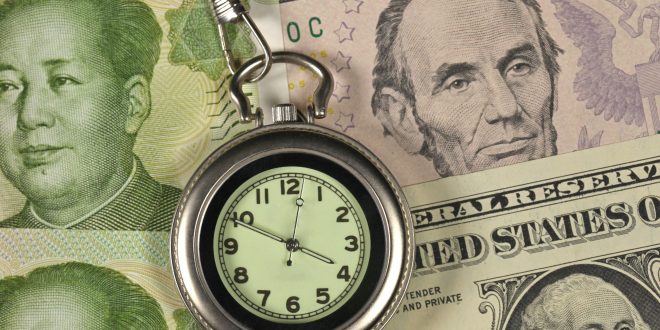In this report, we take a look back at the latest five trading days with a focus on the market news, economic data and headlines that had the most impact on key financial assets; including oil and gold prices as well as the key correlated assets. It is an opportunity to review the key market drivers whose influence on all assets could continue into the future.
Gold, DXY, T-Yields
Gold prices have seen a steady trading range of around $30 for each and every ounce in the spot market, with a potential pickup of 4% in 2024’s second quarter. This week’s macroeconomic data was light, and gold had a mild week of trading despite some expectations of volatility. Spot prices remained at or just below $2320 per ounce as Asian markets opened for Wednesday trading.
The US dollar touched a 38-year high against the Japanese yen early in the week’s story, sparking speculation among traders and analysts about potential Bank of Japan action in the near future. As the US dollar began its strong ascent, purchasers intervened to stabilize gold prices, which were then restrained lower by the start of New York’s midweek session.
In the US morning, the waning gold chart provided an unexpected tailwind from the latest Durable Goods report at the 3rd calculation (second revision) of the US’ Q1 GDP growth rate. The new number for May moderately outperformed expectations, but the prior month’s read was revised lower by up to 60% of the original print. Analysis of new orders for durable goods also fell considerably.
These inputs amounted to a signal that investors believe adds to the argument that the FOMC needs to consider moving to cut rates earlier than expected to avoid a recession if US consumers continue to pullback in spending. Gold prices rallied in the first hours of US trading, regaining its position near $2330.
The print on the PCE Price Index for May, the FOMC’s “preferred” gauge for US inflation, delivered key numbers in line with the market consensus. While this hasn’t lent any upward momentum to gold, it does seem to be providing useful support to Thursday’s gains.
Treasurys rallied modestly on Thursday, sending yields lower, after revised data showed first-quarter annual U.S. gross domestic product grew at a lackluster 1.4% rate.
According to the economic data released on Thursday, the government’s latest estimate of first-quarter annual growth was only slightly above the previous 1.3% estimate for that period. Nonetheless, GDP is forecast to accelerate to 2% in the second quarter. Meanwhile, initial jobless-benefit claims fell by 6,000 to 233,000 in the week.
Oil
Oil prices are expected to gain in the coming months due to a tighter market, rising geopolitical tensions in Eastern Europe and the Middle East, and hopes that the US central bank will start cutting interest rates soon. Brent crude currently trades around $85 a barrel, while the US West Texas Intermediate is at around $82 a barrel.
The latest personal-consumption expenditures price index (PCE) showed inflation moderating in line with expectations, lifting hopes for rate cuts this year. US jobless claims data showed the number of continuing applications for unemployment benefits hit the highest level in more than two years, indicating an easing labor market. Revised GDP estimates indicated the US economy expanded at a 1.4% annual pace from January through March, the slowest quarterly growth since spring 2022. However, recent declines in US consumer confidence are tempering optimism.

Geopolitical risks continue to underpin prices, with concerns over supply disruptions amid persistent drone attacks against energy infrastructure in Russia and Ukraine and border clashes between Israel and Hezbollah. The market is also closely monitoring Europe’s Far Right ascent as well as Iran’s presidential election on Friday, as a more hardline president could result in more direct confrontations with the US, Israel, and Saudi Arabia.

Signs of a tightening market in the third quarter following the extension of OPEC+ supply curbs and summer travel demand are providing support to prices, but uncertainties around the pace of demand in the US and China remain among traders.
Stocks
With all three of the main US stock averages finishing lower on Friday following a stronger opening, Wall Street concluded a solid first half of the year on a somewhat soured note. As tech recovered, the Nasdaq moved up 0.24% for the week. Over the previous five sessions, the Dow Jones Industrial Average and the S&P 500 both had 0.1% declines.
Asian markets ended June with strong performance, driven by optimism about potential Federal Reserve interest rate cuts due to a cooling US economy. South Korea’s KOSPI index saw a 5.9% gain, while India’s Nifty 50 reached a record high of nearly 7%. However, Chinese stocks lost around 3% due to escalating trade tensions with the West and mixed economic data from China. Japan experienced a mixed month, with the Nikkei 225 and TOPIX indexes rising about 0.8% each. The complex interplay of global economic factors and geopolitical tensions will continue to shape the region’s financial landscape.
The coming months will determine whether optimism surrounding easing US monetary policy can sustain Asian stocks’ upward momentum and if China can overcome its challenges to rejoin the broader regional rally.

Trump-Biden Debate
US President Joe Biden and former President Donald Trump are in a high-stakes debate about America’s future, with each candidate presenting different visions for the country’s place in the world. Biden accused Trump of imposing a 10% tariff on all imports, making the average American pay $2500 more per year. Trump defended his plan, claiming that Biden has kept much of the tariffs imposed on hundreds of billions of worth of Chinese goods by his administration. Trump claimed that his plan would lead to countries like China paying them a lot, reducing their deficit, and giving them more power for other things. Biden announced new tariffs on about $18 billion worth of Chinese goods, largely on emerging technologies like electric vehicles and semiconductors. Both candidates presented different visions for America’s place in the world, with Biden criticizing Trump for his threats to withdraw the US from NATO and the 2015 Paris Climate Accords.
The Week Ahead:
Next week, the first trading days of 2024’s second half will be interrupted by Thursday’s July 4th holiday in the United States, and gold prices will hope to consolidate in a period of lower volatility. However, next Friday morning could prove to be a bracing one, as the first item out of the gates after a holiday will be the June NFP report as well as important corporate earnings reports.
 Noor Trends News, Technical Analysis, Educational Tools and Recommendations
Noor Trends News, Technical Analysis, Educational Tools and Recommendations





